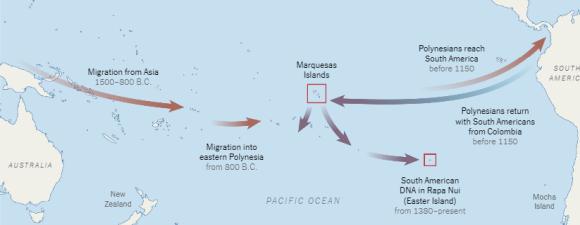
One possible route. Graphic: Jonathan Corum | Source: Nature
For decades scholars have argued over how the myriad islands of Polynesia came to be settled. Did the early settlers sail or drift on rafts from South America on the prevailing currents and then continue to sail westward? Or, did voyagers arrive from the east in double-hulled sailing canoes? If the settlers came from the east, did they ever reach South America in their epic voyages across the Pacific? Did Polynesians and Native Americans ever meet?
A study published in the July 8 issue of the journal Nature may have some of the answers to these questions. A team of researchers led by Alexander G. Ioannidis analyzed the DNA of 807 individuals from 17 Pacific island populations and 15 Pacific coast Native American groups. They found conclusive evidence of Polynesian and Native American contact around AD 1200, which was about the time of the settlement of remote Oceania. The Native American group was most closely related to the indigenous inhabitants of present-day Colombia.
The new study does not, however, answer how the Native Americans and Polynesians came to meet. The recent study suggests that South Americans traveled on their own to a Polynesian island, where Polynesians sailing from the east encountered them. Others argue that it is far more likely that Polynesians who were skilled navigators and developed sailing canoes capable of sailing to windward, traveled to South America and returned to Polynesia with Native Americans.

Harry Maude’s paper on Polynesians in the Peruvian slave trade is very relevant, because this could be a source of a lot of the cross-DNA. Another avenue is a study of rat bones, as edible rats (the Polynesian rat, Rattus exulans, kiore) accompanied Polynesians on their voyages, either deliberately or as stowaways. I was pleased to see Geoff Irwin cited. His work on Polynesian voyaging is inspirational. (https://teara.govt.nz/en/pacific-migrations/print)
The first paragraph confuses Westward direction and the East as term for Asia. Very poor composition.